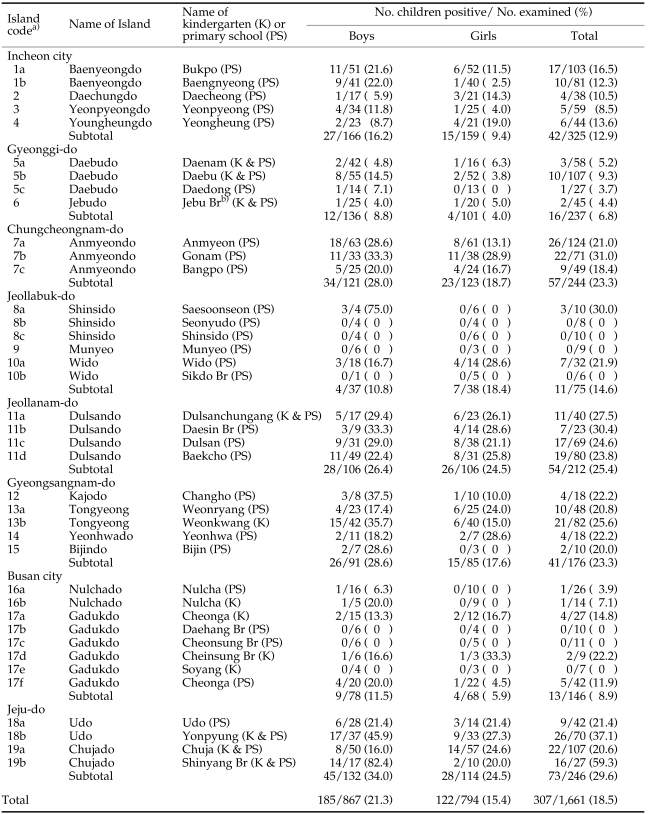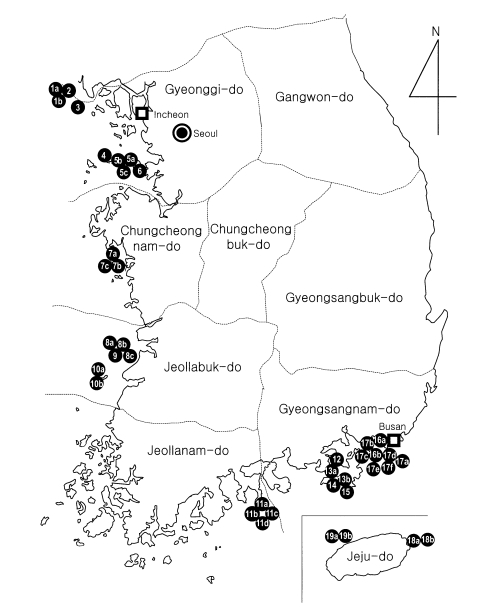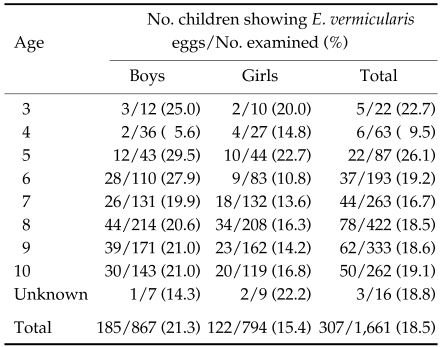Abstract
To determine the status of Enterobius vermicularis infection among children living on western and southern coastal islands of the Republic of Korea, children (3-10 years) in 39 kindergartens and primary schools were examined using the cello-tape anal swab method, during July and August 2000. Of 1,661 children examined, 307 (18.5%) were found to be positive for E. vermicularis eggs. The highest infection rate (59.3%) was found in a kindergarten and a branch school of Shinyang primary school on Chujado, Jeju-do (Province). Remarkable differences in egg positive rates were observed in different localities. The egg positive rate for boys (21.3%) was significantly higher than that of girls (15.4%) (P = 0.02). However, positive rates were not significantly dependent on age. The results of the present study show that E. vermicularis infection is highly prevalent among pre-school and primary school children living on the western and southern coastal islands of the Republic of Korea, and indicate the need for efforts to control this infection.
Keywords: Enterobius vermicularis, enterobiasis, prevalence, cello-tape anal swab, children, islands, Korea
INTRODUCTION
Enterobiasis is a nematode infection caused by the pinworm, Enterobius vermicularis. Its principal mode of transmission is direct contact between infected and uninfected persons. For this reason, this infection is prevalent among primary school children who are easily exposed to overcrowded conditions and inadequate sanitation, and who actively contact each other (Beaver et al. 1984; Cook, 1994).
In the Republic of Korea, E. vermicularis is a common human intestinal parasite among pre-school and primary school children (Chai et al., 1976; Lee et al., 2000; Kim et al., 2003). Even though the national prevalence of soil-transmitted helminth infections has decreased remarkably, for example, only 0.05% of the general population were positive for Ascaris lubmricoides in 2004 (Ministry of Health and Welfare and Korea Association of Health Promotion, 2004). However, the same cannot be said for E. vermicularis, for example, in two nation-wide surveys on the general population in 1997 and 2004, the egg positive rates of E. vermicularis were unchanged at 0.6% (Ministry of Health and Welfare and Korea Association of Health Promotion, 1997, 2004). Moreover, its prevalence among children is much higher than in the general population.
The patterns and prevalence of human helminth infections on coastal islands seem to be quite different from those of the inland (Chai et al., 2001, 2004). For instance, intestinal trematodes including heterophyids and a gymnophallid are prevalent among residents of western and southern coastal islands, i.e., Heterophyes nocens (11.0%), Gymnophalloides seoi (3.8%), and Pygidiopsis summa (1.2%) (Chai et al., 2004). Moreover, because of their geographical isolation, less medical attention has been paid to these areas, and with regard to E. vermicularis infection, no surveys have been conducted. Therefore, the present survey was performed to determine the status of E. vermicularis infection among children living on these off-shore islands of the Republic of Korea.
MATERIALS AND METHODS
A total of 19 western and southern coastal islands in Gyeonggi-do, Incheon city, Chungcheongnam-do, Jeollabuk-do, Jeollanam-do, Gyeongsangnam-do, Busan city, and Jeju-do were involved in this study during July and August 2000, and a total of 39 kindergartens and primary schools were selected (Table 1; Fig. 1). After obtaining informed consent, 1,661 children (3-10 years old) in these schools were examined using the cello-tape anal swab technique (one smear per child), for the presence of E. vermicularis eggs. Skilled laboratory technicians of the branch offices of the Korea Association of Health Promotion (KAHP) collected samples. Anal swabs were transported to the Department of Parasitology and Tropical Medicine, Seoul National University College of Medicine, and examined using a light microscope. Results were analyzed with respect to locality, age, and sex using Fisher's exact test and the chi-square test.
Table 1.
Egg positive rates of Enterobius vermicularis among children living on different islands
a)Area code in Fig. 1.
b)A branch school of the primary school.
Fig. 1.
Areas surveyed (•) for Enterobius vermicularis infection using the cello-tape anal swab technique on western and southern islands of the Republic of Korea.
RESULTS
A total of 307 (18.5%) of the 1,661 samples were positive for E. vermicularis eggs. The egg positive rate ranged from 0% to 59.3% by location (Table 1; Fig. 1). The egg positive rate among boys (21.3%) was significantly higher than that among girls (15.4%) (P = 0.02) (Tables 1, 2). No significant differences in egg positive rates according to age were observed in boys and girls (Table 2).
Table 2.
Age- and sex-prevalence of Enterobius vermicularis infection among kindergarten and primary school children on 19 coastal islandsa)
a)Examined by cello-tape anal swab during July and August 2000.
DISCUSSION
The results of the present study demonstrate a high prevalence (av. 18.5%) of E. vermicularis infection among children attending kindergartens and primary schools on the western and southern islands of the Republic of Korea. This prevalence is higher than those reported by other workers (7.8-17.5%) since 1991 in the Republic of Korea (Kim et al., 1991; Yang et al., 1997; Lee et al., 2000; Yoon et al., 2000, Kim et al., 2003), and is remarkably higher than the national figures of 4.2% for children aged 1-4 years and 3.5% for those aged 5-9 years in 2004 (Ministry of Health and Welfare and Korea Association of Health promotion, 2004).
It is of note that the detection of E. vermicularis eggs from the peri-anal region means the termination of parasitism by the adult worms that produced these eggs (Akagi, 1973; Cho and Kang, 1975), and that such a finding does not necessarily mean that further worms are present in the intestine. Nevertheless, egg detection from the perianal region is significant, because egg positivity indicates a high probability of infection in the intestine (Cho and Kang, 1975).
In the present study, E. vermicularis infection was found to be prevalent in all ages from 3 to 10 years, and boys were more highly infected than girls. Children in this age group contact each other more frequently in kindergartens and primary schools than children of other ages, and are also exposed to unsatisfactory sanitary environments (Chai et al., 1976; Kim et al., 2003). Inadequate personal hygiene could also increase the risk of E. vermicularis infection among children, particularly among boys. Other factors including playing on the floor, nail biting, a failure to wash hands before meals, and living in non-apartment dwellings have also been reported to be associated with the prevalence of enterobiasis (Sung et al. 2001). In this respect, kindergarten- and school-based mass control activities are likely to be more effective than individual treatment.
Enterobiasis is a disease with usually mild symptoms such as, perianal itching and dermatitis; it is asymptomatic in most adults who have low worm burdens. However, in children, particularly who have heavy worm burdens, neurological symptoms including nervousness, restlessness, irritability, and distraction may occur, and these may influence child growth (Beaver et al. 1984; Cook, 1994; Song et al. 2003). Rarely, ectopic infections in the pelvic area or urinary tract of women can occur (Ok et al. 1999; Tandan et al. 2002).
Effective chemotherapeutic regimens have been developed and used for decades; however, the control of enterobiasis is difficult because of frequent reinfection and a short life cycle (Lohiya et al. 2000; Lee et al., 2001). Repeated health education concerning improved personal hygiene and regular inspections and mass chemotherapy with appropriate anthelmintics are essentially required to control enterobiasis among children living on off-shore islands in the Republic of Korea.
ACKNOWLEDGMENTS
We would like to express our appreciation to members of the Korea Association of Health Promotion for performing the cello-tape anal swabs.
Footnotes
This study was supported by a grant from Kangwon National University (2003).
References
- 1.Akagi K. Enterobius vermicularis and enterobiasis. Progress of Medical Parasitology in Japan. 1973;5:229–279. [Google Scholar]
- 2.Beaver PC, Jung RC, Cupp EW. Clinical Parasitology. 9th ed. Philadelphia, USA: Lea & Febiger; 1984. pp. 302–306. [Google Scholar]
- 3.Chai JY, Cho SY, Kang SY, Seo BS. Frequency distribution of Enterobius vermicularis in a highly endemic population. Korean J Parasitol. 1976;14:103–108. doi: 10.3347/kjp.1976.14.2.103. [DOI] [PubMed] [Google Scholar]
- 4.Chai JY, Park JH, Han ET, Shin EH, Kim JL, Hong KS, Rim HJ, Lee SH. A nationwide survey of the prevalence of human Gymnophalloides seoi infection on western and southern coastal islands in the Republic of Korea. Korean J Parasitol. 2001;39:23–30. doi: 10.3347/kjp.2001.39.1.23. [DOI] [PMC free article] [PubMed] [Google Scholar]
- 5.Chai JY, Park JH, Han ET, Shin EH, Kim JL, Guk SM, Hong KS, Lee SH, Rim HJ. Prevalence of Heterophyes nocens and Pygydiopsis summa infections among residents of the western and southern coastal islands of the Republic of Korea. Am J Trop Med Hyg. 2004;71:617–622. [PubMed] [Google Scholar]
- 6.Cho SY, Kang SY. Significance of scotch-tape anal swab technique in diagnosis of Enterobius vermicularis infection. Korean J Parasitol. 1975;13:102–114. doi: 10.3347/kjp.1975.13.2.102. [DOI] [PubMed] [Google Scholar]
- 7.Cook GC. Enterobius vermicularis infection. Gut. 1994;35:1159–1162. doi: 10.1136/gut.35.9.1159. [DOI] [PMC free article] [PubMed] [Google Scholar]
- 8.Kim JS, Lee HY, Ahn YK. Prevalence of Enterobius vermicularis infection and preventive effects of mass treatment among children in rural and urban areas, and children in orphanages. Korean J Parasitol. 1991;29:235–243. doi: 10.3347/kjp.1991.29.3.235. [DOI] [PubMed] [Google Scholar]
- 9.Kim BJ, Lee BY, Chung HK, Lee YS, Lee KH, Chung HJ, Ock MS. Egg positive rate of Enterobius vermicularis of primary school children in Geoje island. Korean J Parasitol. 2003;41:75–77. doi: 10.3347/kjp.2003.41.1.75. [DOI] [PMC free article] [PubMed] [Google Scholar]
- 10.Lee KJ, Lee IY, Im K. Enterobius vermicularis egg positive rate in a primary school in Chungchongnam-do (province) in Korea. Korean J Parasitol. 2000;38:177–178. doi: 10.3347/kjp.2000.38.3.177. [DOI] [PMC free article] [PubMed] [Google Scholar]
- 11.Lee KJ, Ahn YK, Ryang YS. Enterobius vermicularis egg positive rates in primary school children in Gangwon-do (province), Korea. Korean J Parasitol. 2001;39:327–328. doi: 10.3347/kjp.2001.39.4.327. [DOI] [PMC free article] [PubMed] [Google Scholar]
- 12.Lohiya GS, Tan-Figueroa L, Crinella FM, Lohiya S. Epidemiology and control of enterobiasis in a developmental center. West J Med. 2000;172:305–308. doi: 10.1136/ewjm.172.5.305. [DOI] [PMC free article] [PubMed] [Google Scholar]
- 13.Ministry of Health and Welfare, Korea Association of Health Promotion. Prevalence of intestinal parasitic infections in Korea. Seoul, Korea: Urim Inc.; 1997. The 6th report. [Google Scholar]
- 14.Ministry of Health and Welfare, Korea Association of Health Promotion. Prevalence of intestinal parasitic infections in Korea. Seoul, Korea: Art Motion Inc.; 2004. The 7th report. [Google Scholar]
- 15.Ok UZ, Ertan P, Limoncu E, Ece A, Ozbakkaloglu B. Relationship between pinworm and urinary tract infections in young girls. APMIS. 1999;107:474–476. doi: 10.1111/j.1699-0463.1999.tb01582.x. [DOI] [PubMed] [Google Scholar]
- 16.Song HJ, Cho CH, Kim JS, Choi MH, Hong ST. Prevalence and risk factors for enterobiasis among preschool children in a metropolitan city in Korea. Parasitol Res. 2003;91:46–50. doi: 10.1007/s00436-003-0836-3. [DOI] [PubMed] [Google Scholar]
- 17.Sung JF, Lin RS, Huang KC, Wang SY, Lu YJ. Pinworm control and risk factors of pinworm infection among primary-school children in Taiwan. Am J Trop Med Hyg. 2001;65:558–562. doi: 10.4269/ajtmh.2001.65.558. [DOI] [PubMed] [Google Scholar]
- 18.Tandan T, Pollard AJ, Money DM, Scheifele DW. Pelvic inflammatory disease associated with Enterobius vermicularis. Arch Dis Child. 2002;86:439–440. doi: 10.1136/adc.86.6.439. [DOI] [PMC free article] [PubMed] [Google Scholar]
- 19.Yang YS, Kim SW, Jung SH, Huh S, Lee JH. Chemotherapeutic trial to control enterobiasis in schoolchildren. Korean J Parasitol. 1997;35:265–259. doi: 10.3347/kjp.1997.35.4.265. [DOI] [PubMed] [Google Scholar]
- 20.Yoon HJ, Choi YJ, Lee SU, Park HY, Huh S, Yang YS. Enterobius vermicularis egg positive rate of pre-school children in Chunchon, Korea (1999) Korean J Parasitol. 2000;38:279–281. doi: 10.3347/kjp.2000.38.4.279. [DOI] [PMC free article] [PubMed] [Google Scholar]





